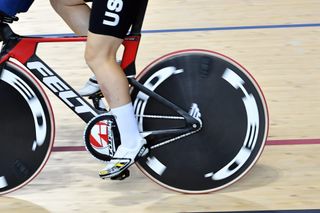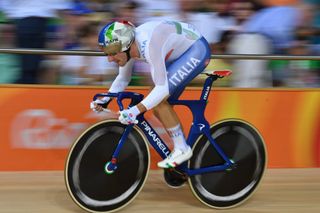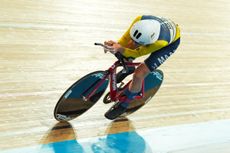Five clever marginal gains that British Cycling didn't think of
Still no stopping the British medal machine despite other countries' best efforts

Britain's cyclists have been utterly dominant in the velodrome at the Rio Olympics, winning seven medals so far (four of them gold) and with a good chance of taking three more golds in the final session this evening.
Alongside natural talent and lots of training, one of the reasons for this success is the fabled marginal gains approach, with aerodynamic socks, carbon-moulded custom shoes, and even telling riders not to shave their pubic hair in order to reduce the problem of saddle sores.
>>> The secret tech that GB cyclists will use to win gold in Rio
Inspired by this, a number of Britain's rivals have come along with their own innovations that British Cycling's "Secret Squirrel Club" didn't come up with.
1. Left hand cranks

While most (if not all) of the British track cycling team are riding the Cervelo T5GB that has been specially developed for the Rio Olympics, these are still very standard track bikes with all of the components in the same place that you would expect from any other bike.
Contrast this with the Felt TA FRD used by most of the American rider, which has the drivetrain positioned on the left hand side of the bike. Not only does this improve the bike's handling as the weight and centre of gravity is shifted to the inside of the velodrome, but also improves the aerodynamics as Felt says that the bike is faster when the airflow is coming from the drivetrain side (as it always is when riding around a velodrome).
2. Custom skinsuits

While all of the British riders seem to be wearing the same model of skinsuit for every event, Elia Viviani was wearing a different Castelii skinsuit for each event as he took victory in the Omnium ahead of Mark Cavendish.
Get The Leadout Newsletter
The latest race content, interviews, features, reviews and expert buying guides, direct to your inbox!
Watch: How much faster can a skinsuit make you?
Each of Viviani's skinsuits has been tested and altered to perform at different speeds, meaning that the fabrics are different for when he's riding at 60kmh for the 1km time trial or 50kmh in the points race.
3. Thru-axle front wheels

While Team GB's Cervelo T5GB's use old-fashioned skewers and bolts to secure the front wheel, a number of other track bikes in the Rio velodrome use thru-axle front wheels for improved aerodynamics.
The Pinarellos used by the Italians and the Look R96 used by the French and a number of other teams feature a thru-axle at the front which means that there is no need for bolts protruding from the side of the axle.
4. Pin-less numbers

One marginal gain that no fewer than three of Britain's track cycling rivals have employed is the use of see-through pockets to attach race numbers, which is slightly more aerodynamic than pinning them on with safety pins.
Riders from the Netherlands, Denmark, and Australia have all used the system from British company Nopinz, which has also supplied the likes of FDJ and LottoNL-Jumbo on the road, while Endura also produces a skinsuit used by Movistar that features a similar number pocket.
5. Waxed chains

In races that can be won or lost by fractions of a second, five watts can make all the difference, which is why a number of Team GB's rivals have been using special chains that have been treated with a special wax to reduce the amount of friction between the links in the chain.
To be fair to GB, they are using Muc-Off's "nano-tube optimised" chain that have been deep-cleaned in a sonic bath and treated with a special lubricant, reportedly costing £6,000 to develop for Bradley Wiggins' Hour Record.

Thank you for reading 20 articles this month* Join now for unlimited access
Enjoy your first month for just £1 / $1 / €1
*Read 5 free articles per month without a subscription

Join now for unlimited access
Try first month for just £1 / $1 / €1
Henry Robertshaw began his time at Cycling Weekly working with the tech team, writing reviews, buying guides and appearing in videos advising on how to dress for the seasons. He later moved over to the news team, where his work focused on the professional peloton as well as legislation and provision for cycling. He's since moved his career in a new direction, with a role at the Department for Environment, Food and Rural Affairs.
-
 Tweets of the week: Pogačar can be beaten, Pidcock meets the royals, and Remco's an Arsenal fan
Tweets of the week: Pogačar can be beaten, Pidcock meets the royals, and Remco's an Arsenal fanSadly for Tadej Pogačar, serial winning doesn't seem to apply to go karting
By Tom Davidson Published
-
 Friday roundup: Rapha does sportswear, Oakley meets PNS and Restrap makes a vest
Friday roundup: Rapha does sportswear, Oakley meets PNS and Restrap makes a vestTwo new clothing lines, some hi-tech smart glasses and a hydration vest to inspire you to ride further
By Luke Friend Published
-
 Welsh Grand Départ for first ever Tour of Britain Women, British Cycling confirms
Welsh Grand Départ for first ever Tour of Britain Women, British Cycling confirmsRace will get underway in Welshpool before concluding in Greater Manchester four days later
By Tom Thewlis Published
-
 Exclusive: Men’s Tour of Britain stages cut to seek parity for women’s race
Exclusive: Men’s Tour of Britain stages cut to seek parity for women’s raceBritish Cycling aim to increase women’s Tour of Britain to six stages in 2025 in order to create full parity between the two events
By Tom Thewlis Published
-
 Talks underway to take Tour of Britain Women to Wales this year
Talks underway to take Tour of Britain Women to Wales this yearWrexham Council in discussions with British Cycling officials to host second stage as race potentially set to start in Wales
By Tom Thewlis Published
-
 British National Road Championships return to Saltburn in 2024
British National Road Championships return to Saltburn in 2024The events will take place in the north east of England for the second year running
By Tom Davidson Published
-
 'My legs are screaming' - 17-year-old stuns with two gold medals at the British Track Championships
'My legs are screaming' - 17-year-old stuns with two gold medals at the British Track ChampionshipsSam Fisher enjoyed a dream day with victories in the team pursuit and scratch race
By Tom Davidson Published
-
 'I'm in shock' - 16-year-old school student wins medal at British Track Championships
'I'm in shock' - 16-year-old school student wins medal at British Track ChampionshipsA-Level student Henry Hobbs rode a blistering kilometre time trial to earn a spot on the podium
By Tom Davidson Published
-
 Olympic hopeful Will Perrett dazzles at British Track Championships
Olympic hopeful Will Perrett dazzles at British Track Championships27-year-old gains three laps to win points race in style, on a night when para-cycling national records tumbled
By Tom Davidson Published
-
 Wout van Aert and Visma-Lease a Bike left out of pocket by Tour of Britain organiser's collapse
Wout van Aert and Visma-Lease a Bike left out of pocket by Tour of Britain organiser's collapsePrize money for 2023 race unpaid, riders union says national federation must ‘bear the debts’ of previous organiser, SweetSpot
By Tom Thewlis Published